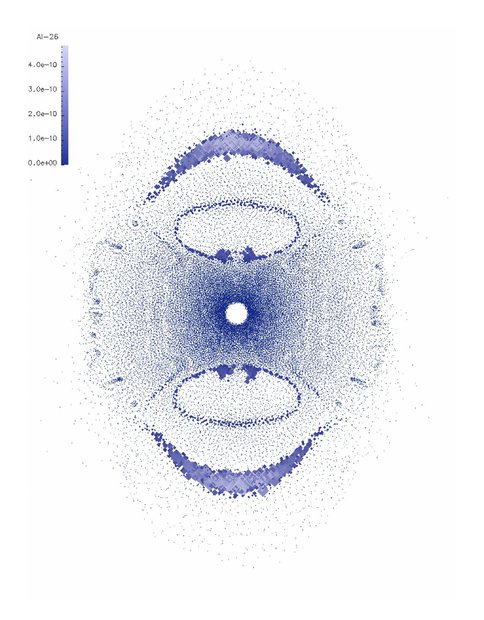2009 Annual Science Report
 Arizona State University
Reporting | JUL 2008 – AUG 2009
Arizona State University
Reporting | JUL 2008 – AUG 2009
Astrophysical Controls on the Elements of Life, Task 2: Model the Chemical and Dynamical Evolution of Massive Stars
Project Summary
In order to understand the distribution of elements both on the scale of the Galaxy and individual solar systems we must understand the production of elements in stars and the dispersal of newly synthesized elements in supernova explosions. We are especially interested in the production and distribution of the radioactive isotope 26Al because the amount of this element present in the early Solar System may have affected the heating of planetesimals and hence their ability to retain water and deliver it to early planets. This task uses computational models of stellar evolution and supernovae with the most accurate treatments of physics available to predict the production elements by individual stars and by populations of stars over time.
Project Progress
Collaborating investigator Patrick Young and grad student Carola Ellinger with support from outside collaborators at the University of Arizona and Los Alamos National Laboratory have completed and published 3D simulations of a core collapse supernova from a massive star. Calculations of 3D explosions of further massive stars are in progress.
Our supernova code has been updated with an improved nuclear reaction network and cooling to model formation of the dense clumps that may participate in element injection. Medium resolution (107 particles) simulations compare models with and without cooling. We plan to have a flagship 108 particle simulation completed by the end of the calendar year. These calculations will be compared with existing 1D explosion yields and are also being processed through a separate multi-D supernova code at Oak Ridge National Laboratory for comparison. Asymmetries and 3D effects have substantial effects on the production of elements which have not been systematically examined. We find that short-lived radioactives especially 26Al are strongly affected.
Investigator Frank Timmes and grad student Georgios Maskotsios have completed a study on the impact of experimentally determined nuclear rates and varying stellar and supernova conditions on the yield of heavy elements.
Young and collaborators from U of A have published our improved theoretical treatment of convection for stellar evolution models.
Young and grad student Nahks Tr’Ehnl have completed and prepared for explosion calculations half of the stellar evolution calculations for the yields of a solar composition population of stars.
Young and grad student Mike Pagano are preparing for submission an analysis of the variation of abundances in stars near the sun and have applied for telescope time with collaborators at the University of Rochester to study the abundances and star formation history of triggered star formation regions in the Scorpius-Centaurus stellar association. This survey will provide estimates of how much abundance variation can be expected in a coeval or near-coeval population of stars and therefore how much element-influence habitability variation there may be in a closely related stellar group.
Figure 1.. 26Al mass per particle for a 10^9 cm thick slice through the x-z plane of an asymmetric supernova explosion. The outer bubble of high 26Al abundance has reached C burning temperatures. The inner ring and bubble reach Ne burning conditions.
Publications
-
Arnett, D., Meakin, C., & Young, P. A. (2008). TURBULENT CONVECTION IN STELLAR INTERIORS. II. THE VELOCITY FIELD. The Astrophysical Journal, 690(2), 1715–1729. doi:10.1088/0004-637x/690/2/1715
-
Ellinger, C. I., Young, P. A., & Desch, S. J. (2010). COLLATERAL EFFECTS ON SOLAR NEBULA OXYGEN ISOTOPES DUE TO INJECTION OF 26 Al BY A NEARBY SUPERNOVA. The Astrophysical Journal, 725(2), 1495–1506. doi:10.1088/0004-637x/725/2/1495
-
Eriksen, K. A., Arnett, D., McCarthy, D. W., & Young, P. (2009). THE REDDENING TOWARD CASSIOPEIA A’s SUPERNOVA: CONSTRAINING THE 56 Ni YIELD. The Astrophysical Journal, 697(1), 29–36. doi:10.1088/0004-637x/697/1/29
-
Young, P. A., Ellinger, C. I., Arnett, D., Fryer, C. L., & Rockefeller, G. (2009). FINDING TRACERS FOR SUPERNOVA PRODUCED 26 Al. The Astrophysical Journal, 699(2), 938–947. doi:10.1088/0004-637x/699/2/938
- Pagano, M., Young, P.A. & Timmes, F.X. (2009). Abundance variation of dwarfs in the solar neighborhood. Astrophysical Journal.
-
PROJECT INVESTIGATORS:
-
PROJECT MEMBERS:
Francis Timmes
Co-Investigator
David Arnett
Collaborator
Chris Fryer
Collaborator
Casey Meakin
Collaborator
Gabriel Rockefeller
Collaborator
Carola Ellinger
Graduate Student
Michael Pagano
Graduate Student
Nahks Tr'Ehnl
Graduate Student
John Huppenthal
Undergraduate Student
-
RELATED OBJECTIVES:
Objective 1.1
Formation and evolution of habitable planets.
Objective 3.1
Sources of prebiotic materials and catalysts

